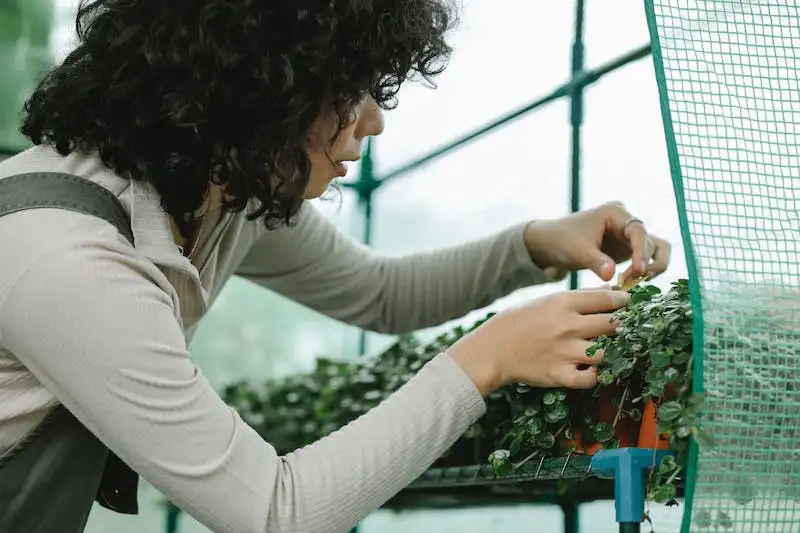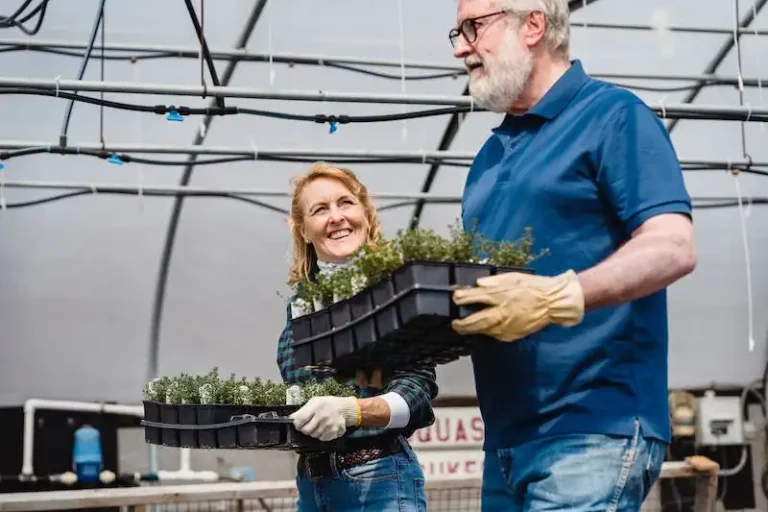Chives, known scientifically as Allium schoenoprasum, are a popular perennial herb that is easy to grow and can be used in various culinary dishes. Native to the south of Europe and parts of Asia, chives are known for their long, thin, and green leaves that grow in clumps and produce purple flowers. They are commonly grown for their flavorful onion-like taste, which adds a fresh and mild flavor to salads, soups, omelets, baked potatoes, and many other dishes.
One of the easiest ways to grow chives is by planting them from seeds. Chives can be sown directly into the garden or started indoors in pots or containers. They have minimal requirements and are quite forgiving when it comes to soil conditions. Chives prefer well-draining soil and are likely to have problems with diseases or pests, making them a low-maintenance herb for any garden.
When planting chives, it’s important to choose a sunny spot in your garden. Chives thrive in full sun, although they can tolerate light shade. They prefer moist soil but are quite drought-tolerant. Watering chives is essential, especially during dry periods, and it’s best to water them lightly but frequently to keep the soil evenly moist.
Chives can also be grown from bulbs or divided clumps. By removing individual bulbs or dividing clumps, you can propagate chives and create new plants. This method is ideal for those who want to move chives to a different part of the garden or share them with friends.
Chives are known for their attractive purple flowers, which not only make them a decorative addition to gardens but also attract pollinators such as bees and butterflies. However, to ensure that chives keep producing leaves, it’s recommended to cut back the flowers as soon as they start to appear. This will divert the plant’s energy to producing fresh leaves rather than flowers.
Overall, chives are a versatile and hardy herb that can be easily grown by novice gardeners. With their attractive appearance, low maintenance requirements, and culinary uses, chives are a great choice for any herb garden. Whether you grow them in pots on your windowsill or in your front yard, chives are sure to add a touch of green and flavor to your gardening experience.
How to grow chives
Chives are a popular herb that can be easily grown from seed or transplants. They are a perennial herb, meaning they will come back year after year. Here are some tips on how to grow chives successfully:
| Attributes | Planting | Care |
|---|---|---|
| Light | Chives prefer full sunlight, but they can tolerate light shade. | Gulf can sometimes be a companion guide. |
| Water | Chives require regular watering, especially during dry periods. | They prefer moderate moisture and high humidity. |
| Soil | Plant chives in well-draining soil that is rich in organic matter. | They can tolerate a wide range of soil conditions. |
| Temperature | Chives can be planted outdoors once the soil has warmed up in early spring. | They’ll begin to grow when the temperature is consistently above 50°F (10°C). |
| Harvest | Chives can be harvested once they have reached a height of 6-8 inches (15-20 cm). | Snip the leaves with scissors and they’ll grow back quickly. |
| Pests and diseases | Chives are generally pest-free, but some common pests include aphids and onion thrips. | Occasionally, chives can be affected by diseases like leaf spot or powdery mildew. |
| Companion plants | Chives are a great companion plant as they can repel aphids and help deter other pests. | They are often planted alongside tomatoes, carrots, and roses. |
| Uses | Chives have a mild, onion-like flavor and are commonly used in salads, soups, omelets, and other dishes. | Their colorful flowers can also be sprinkled on top of dishes or used as a garnish. |
| Storage | Chives can also be stored for later use by drying or freezing. | They can be harvested and dried before the flowers open up. |
By keeping these tips in mind, you can successfully grow chives in your garden or in pots. They are a beautiful and useful herb that can enhance the flavor of many dishes.
Month by Month
Chives are a wonderful herb to have in your garden because they are easy to grow and provide a constant supply of fresh greens for your kitchen. Here is a month-by-month guide to help you care for your chives throughout the year.
January
In January, your chives will be dormant. This is a good time to plan for the upcoming growing season.
February
As the weather begins to warm up, you can start preparing your chive bulbs for planting. Choose a location in your garden that gets full sunlight.
March
In March, you can start planting your chives outdoors. Make sure to water them regularly and keep an eye out for pests like thrips.
April
In April, your chives will begin to show new growth. Keep up with watering and make sure to fertilize them with a recommended herb fertilizer.
May
By May, your chives should be in full bloom. The delicate purple flowers are not only beautiful, but they also add a mild onion flavor to dishes.
June
In June, your chives will continue to grow and can be harvested. Use them fresh or dried to add flavor to your favorite dishes.
July
July is a good time to divide your chives if they have become overcrowded. This will help them stay healthy and vigorous.
August
In August, you can start moving your chives into pots if you want to bring them indoors for the winter. Make sure to give them enough sunlight.
September
September is a good time to start thinking about planting chervil, another herb that goes well with chives.
October
In October, chives may start to die back as the weather gets colder. This is normal, and you can leave them in the ground or move them indoors.
November
In November, you can harvest the last of your chives before they go dormant for the winter.
December
In December, your chives will be dormant. Make sure to give them a good layer of mulch to protect them from the cold.
By following this month-by-month guide, you can ensure that your chives stay healthy and provide you with delicious greens year after year.
Choosing
When choosing a location to grow chives, it is important to select an area with well-drained soil. Chives thrive in full sun, but they can also tolerate some shade. They can be grown as a border plant in the garden or in pots/containers on a patio or balcony.
Chive plants are typically sold as small groups, or clumps, which consist of several individual plants. When planting them, make sure to space them about 8-10 inches apart to allow for their spreading growth habit.
Chives have grass-like leaves that are cylindrical and hollow. The leaves are green in color, although there are some varieties like the ‘Staro’ and ‘Yellow’ chives that have slightly different appearances. Both the leaves and flowers of chives are edible and can be used in a variety of dishes.
Chives are a perennial herb, which means they will come back year after year. They are winter hardy in most regions and will go dormant during the colder months. To help them survive the winter, mulching around the base of the plants can provide added protection and insulation.
Chives are relatively easy to grow and can be propagated from seeds or by dividing an established plant. If you choose to grow them from seeds, start them indoors about 6-8 weeks before the last frost date in your area. Once the chive seedlings are large enough to handle, they can be moved outdoors. If you decide to divide an established plant, dig up the clump and separate the individual plants.
Chives prefer a soil pH that is slightly acidic, around 6.0 to 7.0. If the soil is too alkaline, the chives may have difficulty taking up nutrients and may show signs of nutrient deficiencies, such as yellowing leaves. Adding organic matter, such as compost, can help improve the soil’s fertility.
Chives require regular watering to keep the soil consistently moist. However, they do not tolerate wet conditions and may develop root rot if they are overwatered. Water them deeply and thoroughly, but allow the top inch of soil to dry out before watering again.
When it comes to harvesting chives, you can begin to harvest the leaves once the plant has become established and has developed a good amount of growth. To harvest, simply cut the leaves about an inch or two above the soil with sharp scissors or shears. Harvesting the leaves frequently will encourage new growth.
In addition to their culinary uses, chives can also be grown for their attractive flowers. The purple flowers produced by chives can add a pop of color to the garden and can be used as a garnish for dishes. Removing the flower heads as they appear can help divert the plant’s energy towards leaf production.
Chives are relatively pest-resistant but may occasionally be bothered by thrips or other insects. If you notice any pest activity, remove the affected leaves and control the pests using organic methods.
Overall, chives are a versatile and pleasing herb to have in the garden. They can be a great addition to herb gardens, vegetable beds, or even as a front-of-house planting to provide a pop of green. Whether you choose to grow chives for their culinary flavoring or simply for their beautiful foliage, they’ll be a valuable addition to your gardening plans.
What and where to buy
If you are planning to grow chives as a perennial herb in your garden, there are a few things you need to know about what and where to buy:
Chive seeds: You can buy chive seeds from a local nursery or online. Make sure to purchase fresh seeds from a reliable source.
Chive plants: If you don’t want to grow chives from seeds, you can buy young chive plants from a nursery. This will save you some time and effort in growing them from scratch.
Pots/containers: If you don’t have space in your garden or prefer to grow chives in pots or containers, you can purchase appropriate-sized containers from a gardening store or online.
Organic potting soil: When growing chives in containers, make sure to use organic potting soil that is well-draining and nutrient-rich.
Garden tools: You will need a spade or a garden fork to loosen the soil, a rake to level the surface, and a pair of gardening scissors for harvesting chives.
Mulching material: Chives require a layer of mulch around their base to help conserve moisture and suppress weed growth. You can buy organic mulching materials like shredded leaves or straw.
Other perennial herbs: If you are interested in growing other perennial herbs in your garden, consider buying plants or seeds of herbs like thyme, onions, and garlic.
Remember that chives are hardy in cold climates and can thrive in various conditions. If you live in a region with a classic four-season weather like Colorado, chives are likely to do well in your garden.
By following these tips and buying the necessary supplies, you’ll be ready to plant and grow chives in your garden. If you have any questions or comments about growing chives as a perennial herb, feel free to ask!




